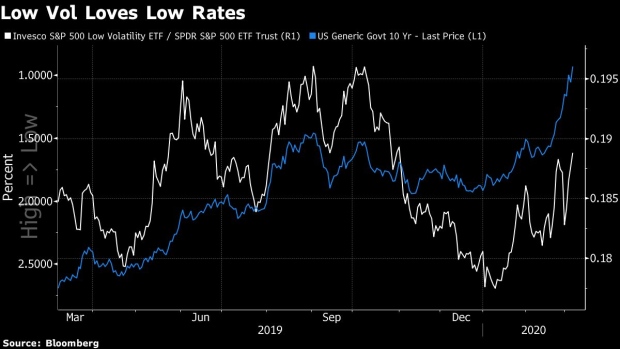Mar 5, 2020
Safety Trade Falls Apart in Market Unhinged by Spread of Virus
, Bloomberg News

(Bloomberg) -- Low-volatility stocks are not living up to their names in turbulent times.
Massive market swings that have seen the S&P 500 Index gain or lose more than 3% in five of the last eight sessions are magnified in the stocks that are supposed to be the calmest. Through Wednesday, the 10-day realized volatility in the S&P 500 Low Volatility Index exceeds that of the equity benchmark itself.
That’s an unusual development during times of market angst. During the risk rout in the fourth quarter of 2018, for instance, low-volatility shares were moving roughly 1 percentage point less than the average stock over one 10-session stretch.
“I was looking at my screen yesterday, when you’re looking at a lot of the more defensive names in the market, the low vol, and they’re up 3, 4, 5, 6% in one day, this ain’t normal,” said Howard Ward, chief investment officer of growth equities at Gabelli Funds. “This ain’t normal.”
Since 1972, there have only been four occasions in which the low-volatility index outperformed on a day in which the S&P 500 was up at least 4%: March 16, 2000; Oct. 20, 2008; and twice this week.
It’s a conundrum: extreme turbulence in markets coupled with plunging interest rates is turning low volatility into high volatility. When correlations tighten and stocks sell off indiscriminately, these names get crushed along with everything else. Automated trading may be playing a role, as well.
Pravit Chintawongvanich, Wells Fargo’s equity derivatives strategist, flagged the poor performance of would-be haven stocks late last week, even in the face of lower Treasury yields.
“This is highly unusual given their lower beta to the S&P, and suggests that index futures selling could be having an outsized impact on single stocks, distorting typical relationships,” he said. This may also hint at selling from target volatility strategies, many of which are tied to low volatility indexes, he added.
Low-volatility stocks last failed to live up to their label during a market drawdown in September 2016, with analysts attributing it to unusually high correlations among members of this cohort because of crowding into the factor. There may be an element of factor drift playing out at this time.
“Utilities seeing -6% performance in risk-off days speaks to bouts of de-grossing, I’d say, considering they are ‘over-owned’ as momentum longs,” said Charlie McElligott, cross-asset macro strategist at Nomura Securities.
Of course, not everyone hates it when volatility is to the upside. The Invesco S&P 500 Low Volatility ETF (SPLV) offers an above-average dividend yield, which becomes more valued as Treasury yields plumb record lows.
Nearly 40% of the fund’s exposure is to utilities and consumer staples -– over three times higher than that of the S&P 500. These companies will likely have more stable cash flows even in the event of a coronavirus-driven economic downturn riddled with social distancing.
Nick Kalivas, senior equity ETF strategist at Invesco, cautioned that anything can happen in short spans. SPLV, he notes, uses trailing one-year volatility to determine its exposures, and on a longer time frame there’s nothing unusual about the product’s gyrations relative to the market at large. But its recent eye-popping gains, he added, likely speak to the perceived safety of dividend streams linked to companies included in SPLV.
“With such a low yield in the U.S., the market is struggling to discern what kind or yield do I want to go to?” Kalivas said. “Wells Fargo with a 5% dividend yield, Exxon at 7% -- but those types of companies could be much more adversely affected by the coronavirus than utilities.”
--With assistance from Rita Nazareth.
To contact the reporter on this story: Luke Kawa in New York at lkawa@bloomberg.net
To contact the editors responsible for this story: Jeremy Herron at jherron8@bloomberg.net, Chris Nagi
©2020 Bloomberg L.P.